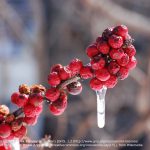 Europeans are familiar with the evergreen holly, Ilex aquifolium, that is used as a midwinter decoration because it is evergreen and shows the promise of new life and growth in the spring. It’s also prized for its red berries. However, not all Ilex species are evergreen, one of the midwinter decorations in North America is the winterberry or Ilex verticillata, and this has stunning red berries on bare stems.
Europeans are familiar with the evergreen holly, Ilex aquifolium, that is used as a midwinter decoration because it is evergreen and shows the promise of new life and growth in the spring. It’s also prized for its red berries. However, not all Ilex species are evergreen, one of the midwinter decorations in North America is the winterberry or Ilex verticillata, and this has stunning red berries on bare stems.
Winterberry is a holly of eastern north america and is much more cold tolerant than it’s more traditionally used evergreen relatives, Ilex aquifolium and Ilex opaca (see maps) which are intolerant of very low temperatures. It arguably has a much greater visual impact than evergreen holly because the berries are not hidden by leaves.

Winterberry in cultivation is suited to damp soils but, like many of its relatives, is dioecious (it has separate male and female plants) so you need to grow a male alongside the berry bearing females. These large shrubs grow 2-4m high and wide so you will need room in your garden if you are to house them. Not all cultivars are red-berried. Fruit colour ranges from yellow through orange to very deep red depending on the cultivar chosen. There is a comprehensive blog on the cultivation of this plant in the US.
Female cultivars: ‘Berry Heavy’, ‘Berry Nice’, ‘Bonfire’, ‘Cacapon’, ‘Jim Dandy’, ‘Red Sprite’, ‘Sparkleberry’
Male cultivars: ‘Apollo’, ‘Raritan Chief’, ‘Southern Gentleman’
Cut stems of winterberry are widely sold in florists. The video below shows the production of those stems from field to harvest.
So, if you’re fed up with being prickled by the traditional evergreen holly, why not try this naked version with its berries on full show.
